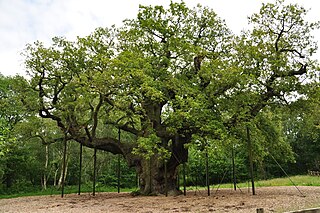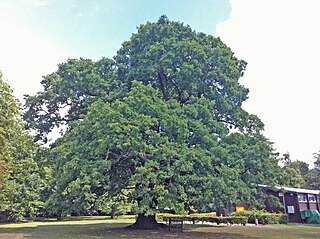
Quercus robur, the pedunculate oak, is a species of flowering plant in the beech and oak family, Fagaceae. It is a large tree, native to most of Europe and western Asia, and is widely cultivated in other temperate regions. It grows on soils of near neutral acidity in the lowlands and is notable for its value to natural ecosystems, supporting a very wide diversity of herbivorous insects and other pests, predators and pathogens.

Allerton is a suburb of Liverpool, England. Historically in Lancashire, it is located 3 miles (4.8 km) southeast of the city centre and is bordered by the suburbs of Garston, Hunt's Cross, Mossley Hill, and Woolton. It has a number of large houses in the prestigious Calderstones Park area, with mainly 1930s semi-detached housing around the shopping area of Allerton Road. It is paired with Hunts Cross to form the Allerton and Hunts Cross city council ward, which had a population of 14,853 at the 2011 census.

Quercus ilex, the evergreen oak, holly oak or holm oak is a large evergreen oak native to the Mediterranean region. It is a member of the Ilex section of the genus, with acorns that mature in a single summer.

The Major Oak is a large English oak near the village of Edwinstowe in the midst of Sherwood Forest, Nottinghamshire, England. According to local folklore, it was Robin Hood's shelter where he and his merry men slept. It weighs an estimated 23 tons, has a girth of 33 feet, a canopy of 92 feet, and is about 800–1,000 years old. In 2014, it was voted 'England's Tree of the Year' by a public poll by the Woodland Trust, receiving 18% of the votes. Its name originates from Major Hayman Rooke's description of it in 1790.

Quercus agrifolia, the California live oak, or coast live oak, is a highly variable, often evergreen oak tree, a type of live oak, native to the California Floristic Province. It may be shrubby, depending on age and growing location, but is generally a medium-sized tree. It grows west of the Sierra Nevada mountain range from Mendocino County, California, south to northern Baja California in Mexico. It is classified in the red oak section of oaks.

Calderstones Park is a public park in Liverpool, Merseyside, United Kingdom. The 126 acres (0.51 km2) park is mainly a family park. Within it there are a variety of different attractions including a playground, a botanical garden and places of historical interest. There is a lake in the park with geese and ducks, and the Calderstones Mansion House, which features a café and a children's play area.

Bowthorpe Oak in Manthorpe near Bourne, Lincolnshire, is a gigantic and ancient pedunculate oak in England. The tree has a circumference of about 44 feet and has a hollow trunk, making it the second-widest individual tree in the UK, only surpassed by the significantly older and much less-intact Marton Oak in Cheshire. It is commonly thought to be the UK's oldest oak tree on account of its size, although it is surpassed in age by the 1,200-year old Marton Oak, and the 1,300-1,500 year old King Offa's Oak at Windsor.

The Knightwood Oak is a pedunculate oak and the largest, and perhaps most famous, oak tree in the New Forest, in southern England. It is also known as the Queen of the Forest. It is over 500 years old and has a girth of 7.38 metres (24.2 ft). The tree is still growing. It was pollarded when about 200 years old and is thought to have been last pollarded in the mid 19th century.

The Darley Oak is a Pedunculate oak tree which grows near Darleyford in the parish of Linkinhorne on the edge of Bodmin Moor, Cornwall, England, UK. This ancient tree is thought to be at least 1,000 years old, and a considerable number of legends take it as their core. Folk tradition attributes healing properties to the tree, and it is said that any wish made to it will eventually come true. Its acorns are also used as amulets, and were once used by pregnant women during pregnancy, to bring them luck. It was chosen one of the 50 Great British Trees by The Tree Council in 2002.

The Suffrage Oak is a Hungarian oak tree in Kelvingrove Park in Glasgow, planted in 1918. It was named Scotland's Tree of the Year in 2015.

The Gilwell Oak is an oak tree on the grounds of The Scout Association's headquarters at Gilwell Park, Essex. It is reputed to have been used as a hiding place by Dick Turpin and since the 20th century has become closely associated with the Scout movement. The tree is situated close to the training ground for the association's first Scout leaders and provided material for the earliest Wood Badges. The oak inspired Scout movement founder Robert Baden-Powell to create "the moral of the acorn and the oak" an analogy for the growth of the Scout movement and the personal growth of its members. The Gilwell Oak was voted England's Tree of the Year by the public in 2017 and was subsequently selected by a panel of experts as the UK Tree of the Year.
The Buttington Oak was a tree near to Offa's Dyke at Buttington, Wales, said to have been planted to mark the site of the Battle of Buttington between the Vikings and a Mercian, Wessex and Welsh force in 893. It had been cyclically pollarded for timber until around 150 years ago. The oak tree was rediscovered in 2009. In 2017 it was badly damaged by storms, finally collapsing in February 2018. The Buttington Yew, also planted in commemoration of the battle in 893, survives and in 2022 was added to the roster of 70 Ancient Trees in The Queen's Green Canopy.

The Tree of the Year competition is held in the United Kingdom in autumn each year by the Woodland Trust, a nationwide conservation charity. Nominated trees are shortlisted by a panel of experts, before going to public votes to select a tree of the year for each of the four constituent countries of the United Kingdom. The panel then selects one of these to become Britain's tree of the year and be nominated for the following year's European Tree of the Year. The competition has been run each year since 2014.

Kilbroney Park is a park near Rostrevor in Northern Ireland. Formerly a country estate, it was visited by William Makepeace Thackeray, Charles Dickens and Seamus Heaney and may have been the inspiration for Narnia in the writings of C. S. Lewis. It came into the ownership of the Bowes-Lyon family, and the future Queen Elizabeth II and Princess Margaret holidayed there as children. The park has been run by Newry, Mourne and Down District Council since 1977 and features a children's play area, tennis courts and a cafe. It has a large collection of rare and historic trees, including "Old Homer", a holm oak that was voted Northern Ireland's Tree of the Year in 2016. A glacial erratic in the park is connected with the legend of the giant Finn Mac Cool.
The Bruce Tree was an oak tree that stood on the grounds of Strathleven House in Dunbartonshire, Scotland. It is reputed to have been planted by Robert the Bruce and was between 700 and 1,000 years old when it fell from an arson attack in May 2004. The timber from the tree was saved and used to form a replica of the Bruce's throne.

The Lottie Sleigh was a sailing barque built in 1852. She was transporting 11 long tons of gunpowder on the River Mersey when she exploded on 15 January 1864. There were no deaths but the explosion caused extensive damage to Birkenhead and its effects were felt across Liverpool. The noise of the explosion could be heard from 39 miles (63 km) away. The Lottie Sleigh was severely damaged and was sold for scrap on 27 January. Discussions over insurance liability for the property damage led to a court decision that is important in insurance case law.

The Caton Oak was an ancient oak tree that stood in Caton, Lancashire, reputedly dating from the time of the druids. The oak tree stood atop a set of steps known as the "Fish Stones" that were used by medieval monks to display salmon for sale. The tree declined during the 20th century and was reinforced with a metal support; an acorn from the tree was planted in 2007 to grow a replacement. The original Caton Oak fell on 20 June 2016.

The Cowthorpe Oak was an oak tree in Cowthorpe, North Yorkshire, England. Renowned for its age and size it was sketched by the artist J. M. W. Turner. At its greatest extent its canopy was said to cover 0.5 acres (2,000 m2) of land. The tree declined in the late 18th century and lost several of its leading branches. By 1822 many of its branches were almost completely rotten and it had been supported with wooden props. The tree fell in 1950, apparently after having been struck by lightning.

The Parliament Oak is a veteran tree in Sherwood Forest. It is reputed to have been the site for impromptu-parliaments held by kings John and Edward I. In the 19th century the tree was propped-up by William Bentinck, 4th Duke of Portland. The tree was shortlisted for the 2017 Woodland Trust Tree of the Year award.

The Newland Oak was a veteran oak tree in Newland, Gloucestershire in England. Originally part of the ancient woodland of the Forest of Dean, it survived clearances that created the settlement of Newland and was afterwards pollarded for timber. Its large size was often remarked upon through the years and it was considered a rival to the Cowthorpe Oak as the largest oak tree in Great Britain. Much of the tree fell during heavy snow in 1955 but a single branch of the tree survived until 1970 when it was killed during an arson attack. A replacement tree grown from one of the Newland Oak's acorns had been planted in 1964.





















